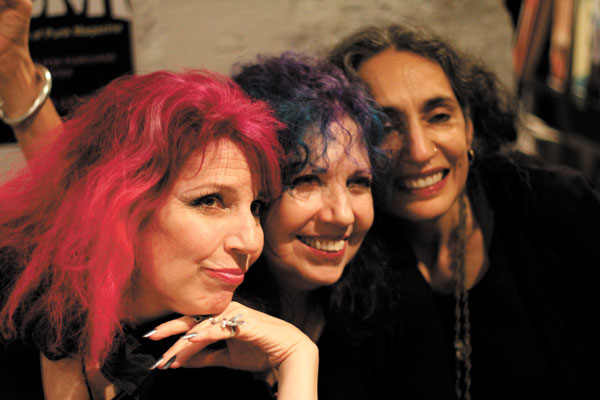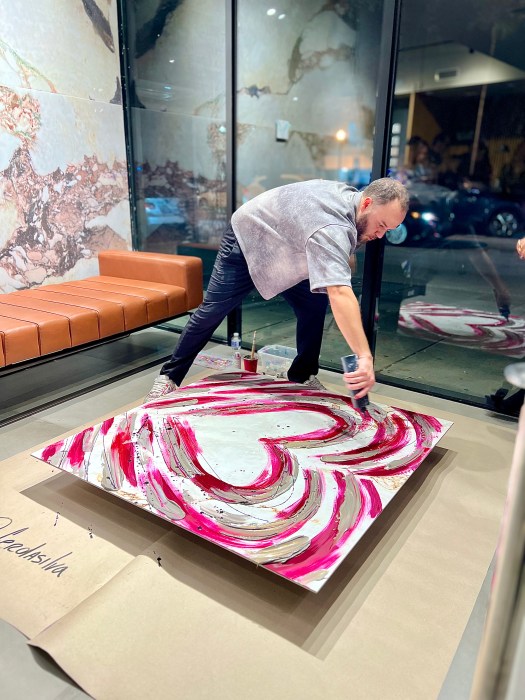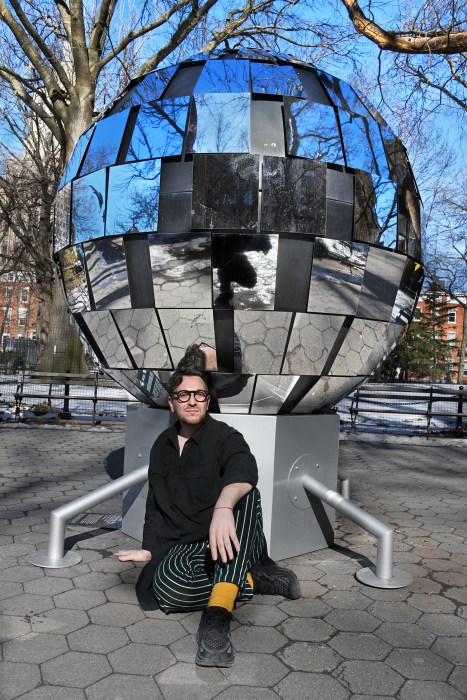
BY PAUL DERIENZO | The book-signing party for “The Best of Punk Magazine” brought together an all-star cabal of artists and writers who were present at the beginning of punk rock in New York in the early and mid-1970s. Their platform at the time was Punk Magazine, which was started by three high school friends, John Holmstrom, Ged Dunn and Legs McNeil, in 1975 and published 17 issues in a short but influential run that came to an end in 1979. A few more issues came out in 2007 and the magazine is available on the Web.
The new book collects the covers, articles, cartoons and artwork that defined the age of black-clad punks who turned the music world and American culture on its head, as the hope and promise of the 1960s faded into the jaded conformity of Reaganism.
The book is the second attempt by Holmstrom, who did the back cover of the Ramones’ “Rocket to Russia” LP, his first book effort failing to attract its market. This time the “Best of Punk Magazine” sits at the top of the Amazon charts, and hundreds came to the Powerhouse Arena in DUMBO to meet former staff members, many of whom haven’t been together in a decade or more.
Among the book signers were writer Mary Harron, who interviewed Sex Pistols front man Johnny Rotten in London in 1976 and returned to New York with a newfound appreciation for the English band’s combination of rebellion and jaded cool. Harron went on from Punk Magazine to direct “I Shot Andy Warhol,” “American Psycho” and “The Notorious Bettie Page.”
“We started the movement” claimed Holmstrom. “There was something before punk rock but it was undefined,” he added. “By giving it a visual definition, we brought it to life.”
Harron was in the news again as Wayne LaPierre, the National Rifle Association vice president, told followers that “corrupt” video game, movie and music video creators “portray life as a joke, portray murder as a way of life, and then have the nerve to call it entertainment.”
“We have blood-soaked films like ‘American Psycho,’ ‘Natural Born Killers,’ they’re aired on propaganda loops called Splatterdays, and every single day.”
Editor Holmstrom seemed ecstatic as he recounted LaPierre’s slings at Harron’s work. Punk, he said, has been “attacked by the left and right,” recounting how Jesse Jackson “censored punk rock” by claiming it was “racist, sexist, fascist.” The charges are untrue said Holmstrom, who added that punk’s critics have often suffered from a lack of a “sense of humor.”
In a recent conversation, Holmstrom opened up a copy of his book to a 1970s-era flier by a leftist group in Madison, Wisconsin, that was demanding a “Boycott of Fascist Culture” claiming that the Sex Pistols “wear swastikas” and that the Ramones had “instigated racial violence in New York City.” The flier went on to accuse punk of reducing women to “sex objects,” offering as proof that “one female group calls itself The Slits.”
Holmstrom and Punk artist Bruce Carleton did work for Al Goldstein’s porn mag Screw, which tempered its arrogant sexism with biting comedy. But Holmstrom also worked for kid-friendly MAD magazine, and with Will Eisner, award-winning creator of The Spirit comic character and many other innovative cartoons.
Despite the sexism slag, Punk did feature its share of female groups and leads. Debbie Harry, whose music started as punk but soon crossed over to pop and even disco, wrote the forward to “The Best of Punk Magazine.” Blondie was also the cover of Punk issue No. 10 in 1977, with Debbie Harry’s cartoon figure performing live on the cover. A cartoon bust of Lou Reed graced the cover of the new magazine’s inaugural issue. Patti Smith was on the cover of the second edition, with Joey Ramone on the third. The Ramones lead singer, who died in 2001, was a co-editor of Punk Magazine. He was involved in naming the magazine’s “Punk of the Month” and in creating the magazine’s signature photo comics.
Gathered in Brooklyn at the Powerhouse Arena party were the artists and performers who came to sign copies of “The Best of Punk Magazine.” Sisters Tish and Snooky Bellomo, who sang backup for Blondie and still perform with their group the Sic F—-, posed for photos, while cover artists Bruce Carleton and Steve Taylor signed books. Tish and Snooky also opened the first punk rock boutique on St. Mark’s Place, called Manic Panic, and market their own line of cosmetics.
Rock photographer Bob Gruen, who documented punk personalities, was there, as were visual artists Curt Hoppe, Thom Holaday, Roberta Bayley and Robert Romagnoli.
Bayley worked together with Holmstrom editing a fumetti by Legs McNeil called “The Legend of Nick Detroit.” A fumetti, Italian for “little puffs of smoke,” is a comic strip made with photos instead of drawings and with speech balloons. The story is of a former top international agent and super-killer named Nick Detroit battling the Nazi Dykes and their schemes for world domination. The story appeared in issue No. 6 of Punk and featured Debbie Harry, Patti Smith guitarist Lenny Kaye, and starred punk rocker Richard Hell in the title role.
Does punk have a political agenda? Bands like MDC, a.k.a Millions of Dead Cops — later changed to Millions of Dead Chickens because band members were vegan — Dead Kennedys, Tom Robinson Band with their torch song “Glad To Be Gay,” and The Clash among others had a decidedly antiestablishment bent. But Holmstrom adamantly said, “No.” He also denied that the U.S. ever harbored a movement of fascist skinheads like some punks in England.
He said instead punk started with a band called The Dictators. Their 1975 debut album was “Go Girl Crazy,” which included two songs, “Master Race Rock” and “Back to Africa” that generated controversy at the time, although most of the band members are Jewish. Holmstrom said that punks actually “were Jews making fun of Nazis.”
“Go Girl Crazy” was a parody influenced by the progressive heavy metal band Blue Oyster Cult, according to Holmstrom, who calls it the first true punk album. He recounted an early conflict when Handsome Dick Manitoba of the Dictators and Wayne County, rock’s first transsexual singer, now known as Jayne County, got into an altercation at CBGB that started as a staged fight but got out of hand with Manitoba hit by a mic stand. Since that incident, Jayne and Handsome Dick Manitoba have recorded together and are friends. But allegations that punk is violent or incites violence have dogged punk musicians from its earliest days.
Is punk music violent?
“Only when necessary,” Holmstrom said, adding that, “We live in a dog-eat-dog world.” But he doesn’t believe the N.R.A.’s allegation that punk is responsible “for murders in America.”
“Look at the first punk band,” chided Holmstrom, referring to The Stooges. They’re “named after the Three Stooges,” known for their violent skits, he said, adding that “the most dangerous people in our society have no sense of humor.”
But the controversy hasn’t made punk’s acceptance any easier. Holmstrom laughed as he recounted how “Maus” creator Art Spiegelman called him an “a–hole” at a party where a discussion of punk music came up.
Holmstrom is often credited with helping launch punk as an artistic style. He credits as a major influence the mysterious magazine promoter, cultural bomb-thrower and marijuana smuggler known by several names including Tom Forcade, who in 1978 took his own life with a pearl-handled revolver in his West Village apartment. Forcade credits include High Times, the venerable pro-pot monthly he started in 1974.
“Forcade was the biggest fan of punk rock I ever met in any life” said Holmstrom. “He paid for me to go on tour with the Sex Pistols.”
The band and the Pistols’ U.S. tour were the brainchild of Malcolm McLaren, who operated the London boutique Sex, where he sold punk-style clothing while plotting his takeover of pop culture.
After being repeatedly rebuffed by McLaren, the determined Forcade had his film crew follow the Pistols’ tour, filming the seven performances across the Southeast and Texas, while interviewing the musicians and fans.
“Malcolm didn’t want to play the usual venues,” said Holmstrom. “He wanted to cause problems.”
“D.O.A.: A Rite of Passage” reportedly cost Forcade $400,000 to produce, and he died before it was released. The tour dates were mostly in the southern part of the country and were packed with fans that included rednecks, alienated teens and folks who were just curious. The band’s notoriety ensured a big police presence at every show and fans inside and outside the concert halls fought, drank and did drugs.
In the film it appears that everyone had a great time, although the budding relationship between bassist Sid Vicious in his swastika T-shirt and Philadelphia-born superfan Nancy Spungen, who was Jewish, would end with her death at the Chelsea Hotel within a few months, followed by his death, overdosing in an apartment on Bank St.
At the San Antonio show Sid Vicious uses his guitar like an ax to take out a heckler in the audience. Holmstrom recalled the incident but claimed that shortly before the band’s el kabong moment, he saw “Sid take a beer can in the face” thrown from the audience, adding Sid glared back at the perpetrator with a look of “like hit me again mother——.”
Holmstrom said at that moment “the lights and sound went off and it got scary.” Outside a man who said he was hit by the bass asserted, “I don’t like what they are doing, as far as I’m concerned they’re not worth killing.” Holmstrom is credited in the film with “titles and graphic design” along with Punk Magazine artists Taylor and Carleton.
In the years after the breakup of the Sex Pistols punk separated into subgenres from commercial New Wave to skinhead, grunge and alternative rock, eventually penetrating into every corner of the world.
Politically conscious punk, like its hip hop counterpart, confronted racist statements by some musicians and countered the growth of white nationalist groups in England. Activists were prompted to organize a concert with an antiracist theme, and what started as one concert soon spread across the Atlantic to New York where it caught the imagination of punk fans, politicos and members of the Yippies, based at 9 Bleecker St.
The coalition put on concerts in Central Park’s band shell annually each May until they were forced out by the city after a legal battle that went to the Supreme Court in 1989. Civil rights lawyer William Kunstler defended the concert’s use of its own sound system as integral to the musicians’ and activists’ artistic and free speech rights. But City Hall claimed the concerts were too loud, eliciting complaints from neighbors in tony neighborhoods blocks away. The court ruled against the organizers, in the end allowing the city to force Rock Against Racism to use a city-supplied sound engineer, effectively ending the use of the band shell for independent rock shows.
Is punk dead?
“It’s very much alive,” asserted Holmstrom. “It’s a worldwide phenomenon. It’s big in Japan and all throughout Europe.”
Recently members of the Russian all-girl punk band Pussy Riot were sentenced to prison for singing on the altar of a Moscow cathedral.
“People said it would be a fad and it would die after a few years,” recalled Holmstrom, “but it was just starting.” According to him, the naysayers often repeated the opinion of others, but the lesson of punk music is just the opposite: “You have to think for yourself. You can’t let other people tell you what to think.”
Whatever the criticism of punk, it’s definitely a movement of folks who think for themselves.
DeRienzo is cohost of “Let Them Talk,” every Tuesday at 8 p.m. on MNN’s Lifestyle channel. Thanks to Joan Moossy for her contribution to this article.


































